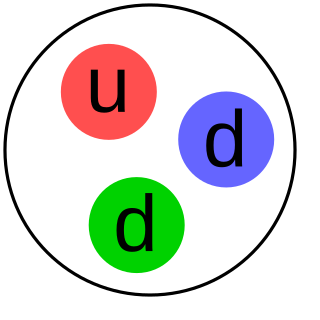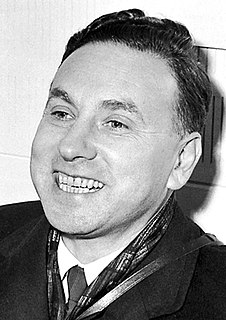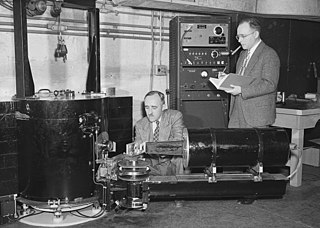
Franco Dino Rasetti was an Italian physicist who, together with Enrico Fermi, discovered key processes leading to nuclear fission. Rasetti refused to work on the Manhattan Project on moral grounds.

Small-angle neutron scattering (SANS) is an experimental technique that uses elastic neutron scattering at small scattering angles to investigate the structure of various substances at a mesoscopic scale of about 1–100 nm.

Robert Hofstadter was an American physicist. He was the joint winner of the 1961 Nobel Prize in Physics "for his pioneering studies of electron scattering in atomic nuclei and for his consequent discoveries concerning the structure of nucleons".

Neutron diffraction or elastic neutron scattering is the application of neutron scattering to the determination of the atomic and/or magnetic structure of a material. A sample to be examined is placed in a beam of thermal or cold neutrons to obtain a diffraction pattern that provides information of the structure of the material. The technique is similar to X-ray diffraction but due to their different scattering properties, neutrons and X-rays provide complementary information: X-Rays are suited for superficial analysis, strong x-rays from synchrotron radiation are suited for shallow depths or thin specimens, while neutrons having high penetration depth are suited for bulk samples.

Bertram Neville Brockhouse, was a Canadian physicist. He was awarded the Nobel Prize in Physics "for pioneering contributions to the development of neutron scattering techniques for studies of condensed matter", in particular "for the development of neutron spectroscopy".

John Ray Dunning was an American physicist who played key roles in the Manhattan Project that developed the first atomic bombs. He specialized in neutron physics, and did pioneering work in gaseous diffusion for isotope separation. He was Dean of the School of Engineering and Applied Science at Columbia University from 1950 to 1969.

Hydrogen (1H) has three naturally occurring isotopes, sometimes denoted 1H, 2H, and 3H. The first two of these are stable, while 3H has a half-life of 12.32 years. All heavier isotopes are synthetic and have a half-life less than one zeptosecond. Of these, 5H is the most stable, and 7H is the least.
There are 21 recognized isotopes of sodium (11Na), ranging from 18
Na to 39
Na and two isomers. 23
Na is the only stable isotope. As such, it is considered a monoisotopic element and it has a standard atomic weight of 22.98976928(2). Sodium has two radioactive cosmogenic isotopes. With the exception of those two, all other isotopes have half-lives under a minute, most under a second. The shortest-lived is 18
Na, with a half-life of 1.3(4)×10−21 seconds.
Natural nitrogen (7N) consists of two stable isotopes, nitrogen-14, which makes up the vast majority of naturally occurring nitrogen, and nitrogen-15, which is less common. Fourteen radioactive isotopes (radioisotopes) have also been found so far, with atomic masses ranging from 10 to 25, and one nuclear isomer, 11mN. All of these radioisotopes are short-lived, with the longest-lived one being nitrogen-13 with a half-life of 9.965 minutes. All of the others have half-lives below 7.15 seconds, with most of these being below five-eighths of a second. Most of the isotopes with atomic mass numbers below 14 decay to isotopes of carbon, while most of the isotopes with masses above 15 decay to isotopes of oxygen. The shortest-lived known isotope is nitrogen-10, with a half-life of about 200 yoctoseconds.

Neutron detection is the effective detection of neutrons entering a well-positioned detector. There are two key aspects to effective neutron detection: hardware and software. Detection hardware refers to the kind of neutron detector used and to the electronics used in the detection setup. Further, the hardware setup also defines key experimental parameters, such as source-detector distance, solid angle and detector shielding. Detection software consists of analysis tools that perform tasks such as graphical analysis to measure the number and energies of neutrons striking the detector.
The neutron magnetic moment is the intrinsic magnetic dipole moment of the neutron, symbol μn. Protons and neutrons, both nucleons, comprise the nucleus of atoms, and both nucleons behave as small magnets whose strengths are measured by their magnetic moments. The neutron interacts with normal matter through either the nuclear force or its magnetic moment. The neutron's magnetic moment is exploited to probe the atomic structure of materials using scattering methods and to manipulate the properties of neutron beams in particle accelerators. The neutron was determined to have a magnetic moment by indirect methods in the mid 1930s. Luis Alvarez and Felix Bloch made the first accurate, direct measurement of the neutron's magnetic moment in 1940. The existence of the neutron's magnetic moment indicates the neutron is not an elementary particle. For an elementary particle to have an intrinsic magnetic moment, it must have both spin and electric charge. The neutron has spin 1/2 ħ, but it has no net charge. The existence of the neutron's magnetic moment was puzzling and defied a correct explanation until the quark model for particles was developed in the 1960s. The neutron is composed of three quarks, and the magnetic moments of these elementary particles combine to give the neutron its magnetic moment.
Jump diffusion is a stochastic process that involves jumps and diffusion. It has important applications in magnetic reconnection, coronal mass ejections, condensed matter physics, in Pattern theory and computational vision and in option pricing.
In physics, the Lamb–Mössbauer factor or elastic incoherent structure factor (EISF) is the ratio of elastic to total incoherent neutron scattering, or the ratio of recoil-free to total nuclear resonant absorption in Mössbauer spectroscopy. The corresponding factor for coherent neutron or X-ray scattering is the Debye–Waller factor; often, that term is used in a more generic way to include the incoherent case as well.
Aleksander Ilyich Akhiezer was a Soviet theoretical physicist, known for contributions to numerous branches of theoretical physics, including quantum electrodynamics, nuclear physics, solid state physics, quantum field theory, and the theory of plasma. He was the brother of the mathematician Naum Akhiezer.
The rms charge radius is a measure of the size of an atomic nucleus, particularly of a proton or a deuteron. It can be measured by the scattering of electrons by the nucleus and also inferred from the effects of finite nuclear size on electron energy levels as measured in atomic spectra.

Richard Edward Taylor,, was a Canadian physicist and Stanford University professor. He shared the 1990 Nobel Prize in Physics with Jerome Friedman and Henry Kendall "for their pioneering investigations concerning deep inelastic scattering of electrons on protons and bound neutrons, which have been of essential importance for the development of the quark model in particle physics."

Sow-Hsin Chen, is a Hoklo Taiwanese physicist and Professor Emeritus at Massachusetts Institute of Technology (MIT). He is a recognized pioneer in the research of the dynamic properties of supercooled and interfacial water with the use of neutron scattering techniques. As an educator, he has been recognized for his training of young scientists in the use of those same techniques. Regarding hydrogen storage, his research focuses on the use of activated carbon to allow hydrogen to be stored at room temperature.

Ernest Omar Wollan was an American physicist who made major contributions in the fields of neutron scattering and health physics.
Varley Fullerton Sears is a Canadian physicist, notable for his contributions to the methodological foundations of neutron scattering.








